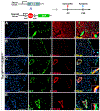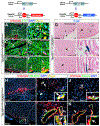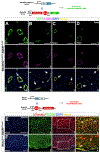Limited Regeneration Potential with Minimal Epicardial Progenitor Conversions in the Neonatal Mouse Heart after Injury
- PMID: 31269439
- PMCID: PMC6837841
- DOI: 10.1016/j.celrep.2019.06.003
Limited Regeneration Potential with Minimal Epicardial Progenitor Conversions in the Neonatal Mouse Heart after Injury
Abstract
The regeneration capacity of neonatal mouse heart is controversial. In addition, whether epicardial cells provide a progenitor pool for de novo heart regeneration is incompletely defined. Following apical resection of the neonatal mouse heart, we observed limited regeneration potential. Fate-mapping of Tbx18MerCreMer mice revealed that newly formed coronary vessels and a limited number of cardiomyocytes were derived from the T-box transcription factor 18 (Tbx18) lineage. However, further lineage tracing with SM-MHCCreERT2 and Nfactc1Cre mice revealed that the new smooth muscle and endothelial cells are in fact derivatives of pre-existing coronary vessels. Our data show that neonatal mouse heart can regenerate but that its potential is limited. Moreover, although epicardial cells are multipotent during embryogenesis, their contribution to heart repair through "stem" or "progenitor" cell conversion is minimal after birth. These observations suggest that early embryonic heart development and postnatal heart regeneration are distinct biological processes. Multipotency of epicardial cells is significantly decreased after birth.
Keywords: cell lineage tracing; epicardial cells; heart regeneration; neonatal mouse.
Copyright © 2019 The Author(s). Published by Elsevier Inc. All rights reserved.
Conflict of interest statement
DECLARATION OF INTERESTS
The authors declare no competing interests.
Figures







Similar articles
-
A myocardial lineage derives from Tbx18 epicardial cells.Nature. 2008 Jul 3;454(7200):104-8. doi: 10.1038/nature06969. Epub 2008 May 14. Nature. 2008. PMID: 18480752 Free PMC article.
-
Tbx18 and the fate of epicardial progenitors.Nature. 2009 Apr 16;458(7240):E8-9; discussion E9-10. doi: 10.1038/nature07916. Nature. 2009. PMID: 19369973
-
Tbx18 regulates development of the epicardium and coronary vessels.Dev Biol. 2013 Nov 15;383(2):307-20. doi: 10.1016/j.ydbio.2013.08.019. Epub 2013 Sep 7. Dev Biol. 2013. PMID: 24016759 Free PMC article.
-
The epicardium in cardiac repair: from the stem cell view.Pharmacol Ther. 2011 Jan;129(1):82-96. doi: 10.1016/j.pharmthera.2010.09.002. Epub 2010 Oct 19. Pharmacol Ther. 2011. PMID: 20937304 Review.
-
Non-Cardiomyocytes in Heart Regeneration.Curr Drug Targets. 2018;19(9):1077-1086. doi: 10.2174/1389450119666180518111931. Curr Drug Targets. 2018. PMID: 29773058 Review.
Cited by
-
Wnt Signaling in Heart Development and Regeneration.Curr Cardiol Rep. 2022 Oct;24(10):1425-1438. doi: 10.1007/s11886-022-01756-8. Epub 2022 Aug 4. Curr Cardiol Rep. 2022. PMID: 35925512 Review.
-
Age-Related Pathways in Cardiac Regeneration: A Role for lncRNAs?Front Physiol. 2021 Jan 20;11:583191. doi: 10.3389/fphys.2020.583191. eCollection 2020. Front Physiol. 2021. PMID: 33551829 Free PMC article. Review.
-
Epicardial Contribution to the Developing and Injured Heart: Exploring the Cellular Composition of the Epicardium.Front Cardiovasc Med. 2021 Sep 23;8:750243. doi: 10.3389/fcvm.2021.750243. eCollection 2021. Front Cardiovasc Med. 2021. PMID: 34631842 Free PMC article. Review.
-
The Role of the Epicardium During Heart Development and Repair.Circ Res. 2020 Jan 31;126(3):377-394. doi: 10.1161/CIRCRESAHA.119.315857. Epub 2020 Jan 30. Circ Res. 2020. PMID: 31999538 Free PMC article. Review.
-
Animal models to study cardiac regeneration.Nat Rev Cardiol. 2024 Feb;21(2):89-105. doi: 10.1038/s41569-023-00914-x. Epub 2023 Aug 14. Nat Rev Cardiol. 2024. PMID: 37580429 Review.
References
-
- Andersen DC, Jensen CH, Baun C, Hvidsten S, Zebrowski DC, Engel FB, and Sheikh SP (2016). Persistent scarring and dilated cardiomyopathy suggest incomplete regeneration of the apex resected neonatal mouse myocardium–A 180 days follow up study. J. Mol. Cell. Cardiol 90, 47–52. - PubMed
-
- Beltrami AP, Barlucchi L, Torella D, Baker M, Limana F, Chimenti S, Kasahara H, Rota M, Musso E, Urbanek K, et al. (2003). Adult cardiac stem cells are multipotent and support myocardial regeneration. Cell 114, 763–776. - PubMed
Publication types
MeSH terms
Substances
Grants and funding
LinkOut - more resources
Full Text Sources
Medical
Molecular Biology Databases
Research Materials

